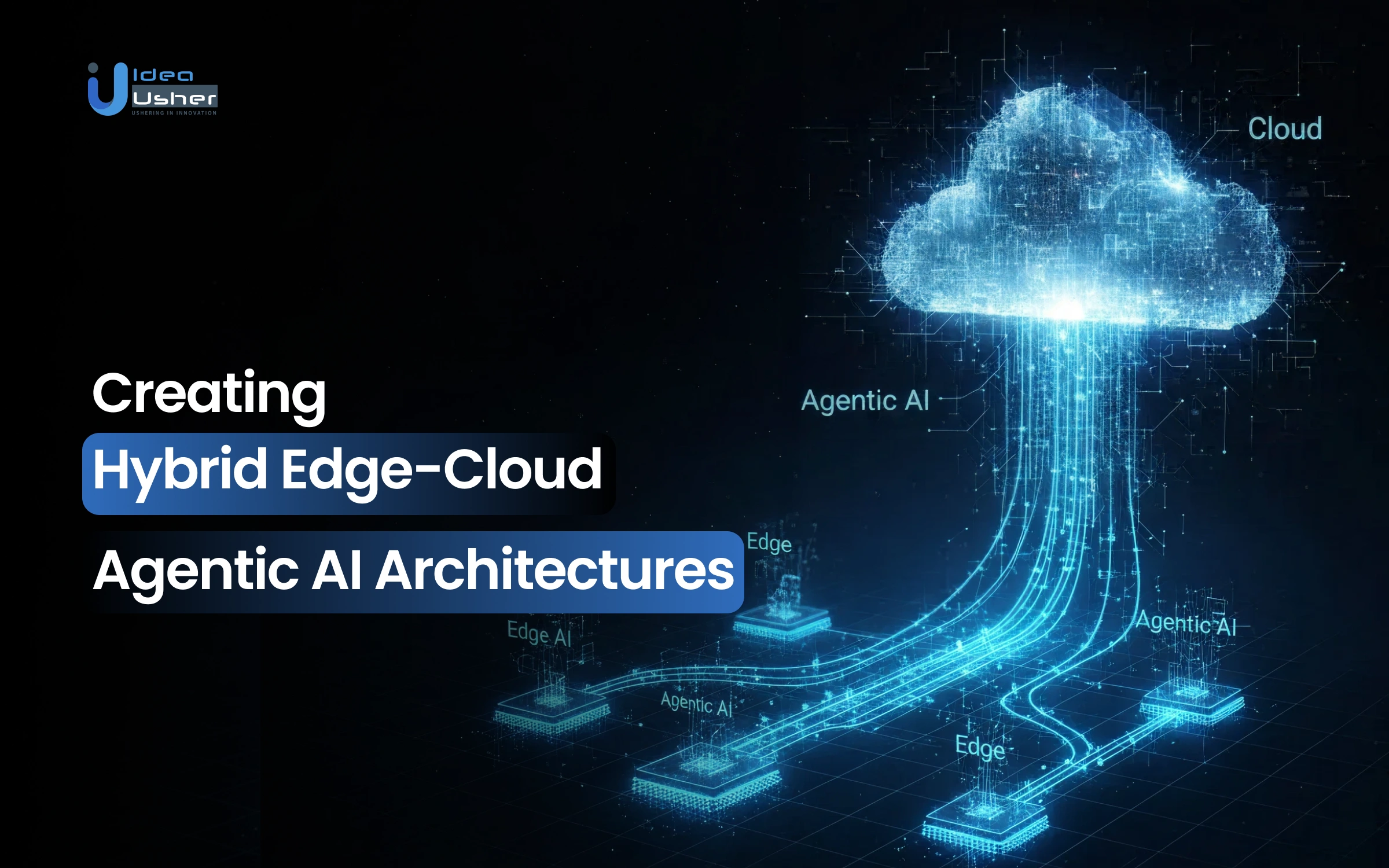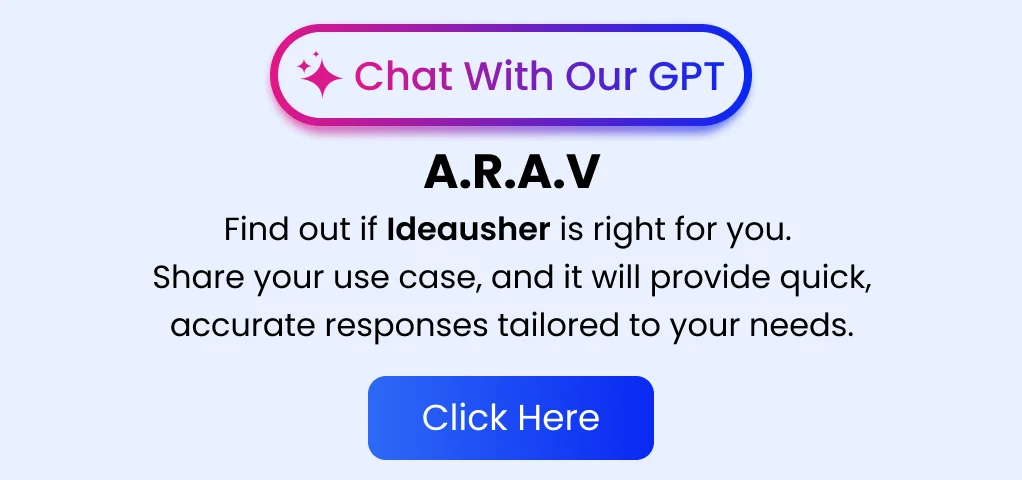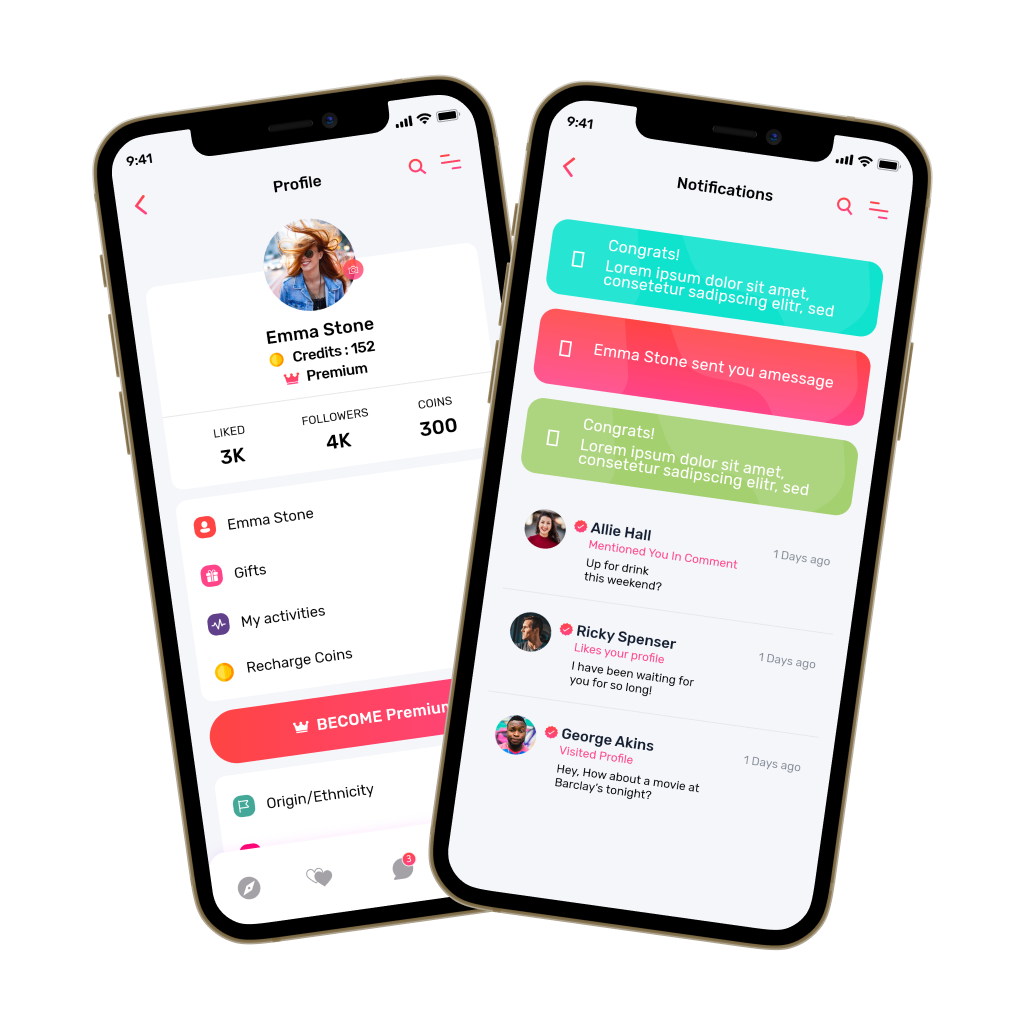The world of AI is moving beyond traditional data centers and isolated edge devices. Businesses now require systems that can respond quickly and intelligently at the point where data is generated. Standard cloud systems may struggle to keep up with the need for speed and decentralization. That’s why many companies are adopting hybrid edge-cloud agentic AI architectures. These systems combine the edge’s real-time decision-making with the cloud’s powerful computational capabilities.
They allow AI agents to act autonomously yet still work together as part of a larger system. This approach offers the flexibility to continuously adapt and improve in real time.
We’ve partnered with a lot of businesses across manufacturing, logistics, retail, and energy sectors, delivering powerful agentic AI solutions powered by edge computing and machine learning technologies. We’re sharing this blog to guide you through the essential steps for building robust hybrid edge-cloud agentic AI architectures. Let’s dive in and explore how to get started!
Key Market Takeaways for Agentic AI Architectures
According to MordorIntelligence, the agentic AI market is growing at a fast pace, expected to surge from USD 6.96 billion in 2025 to USD 42.56 billion by 2030, marking an impressive CAGR of 43.61%. This growth is fueled by the increasing adoption of hybrid edge-cloud architectures, which combine the benefits of local edge computing with the powerful capabilities of cloud-based AI. This blend allows businesses to optimize performance, reduce latency, and enhance scalability for AI-driven applications.
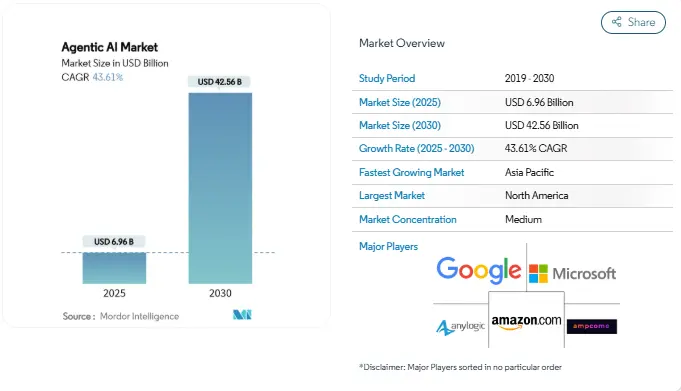
Source: MordorIntelligence
Hybrid edge-cloud systems are particularly attractive for industries like defense, healthcare, and finance, where both data security and high-performance computing are critical. With edge computing handling real-time, latency-sensitive tasks locally, and the cloud managing complex analysis and orchestration, businesses can deploy AI solutions that are both fast and intelligent.
This approach also ensures that sensitive data stays on-site, meeting regulatory requirements and maintaining security.
An example of this innovation is Solace’s Agent Mesh, an open-source framework designed to support event-driven, multi-agent collaboration across both edge and cloud environments. It uses intelligent orchestrators to allocate tasks to specialized AI agents, regardless of where they are located.
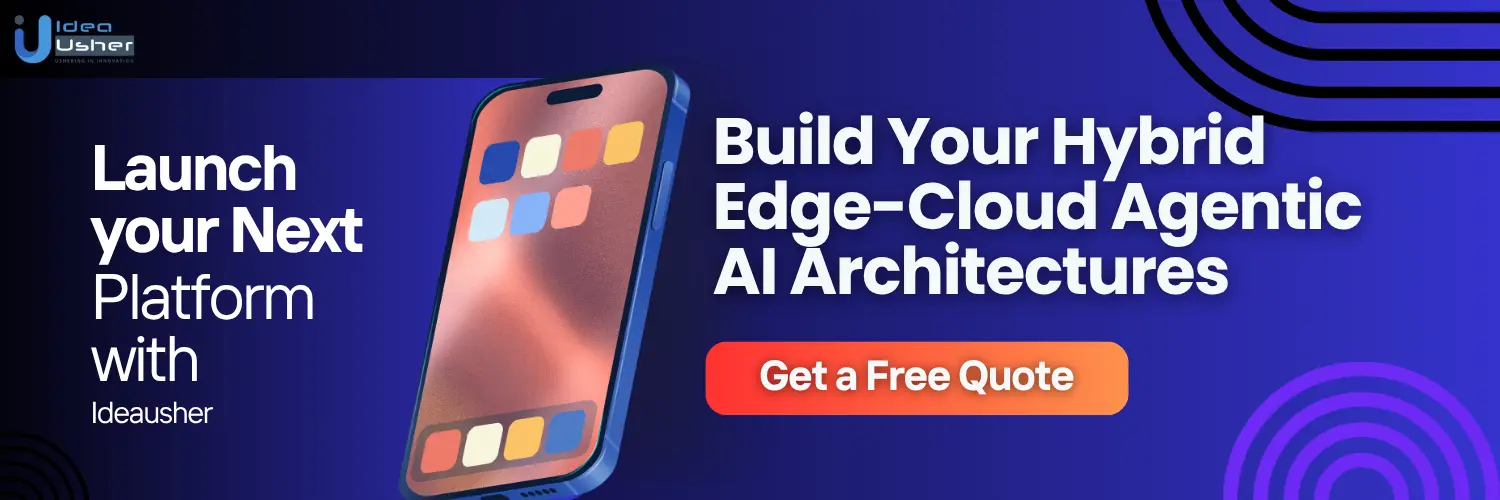
Understanding Hybrid Edge-Cloud Agentic AI Architectures
Hybrid edge-cloud agentic AI architectures combine edge and cloud computing to enable intelligent, autonomous decision-making. In this system, data processing and AI models are distributed between edge devices (like IoT devices) and centralized cloud infrastructure.
Edge devices handle real-time tasks, processing data locally for low-latency decisions. The cloud, on the other hand, offers scalability and powerful computing resources for training and refining AI models.
The “agentic” aspect means the system can make autonomous decisions and take actions without constant human intervention. It integrates learning and decision-making capabilities across both edge and cloud environments.
How Hybrid Edge-Cloud Agentic AI Architectures Work?
Hybrid edge-cloud agentic AI architectures blend the processing power of edge devices with cloud computing to enable fast decision-making. They allow AI models to run locally on the edge for real-time tasks while leveraging the cloud for more intensive processing or data storage. This combination ensures that systems can be both responsive and scalable, delivering efficiency across varied applications.
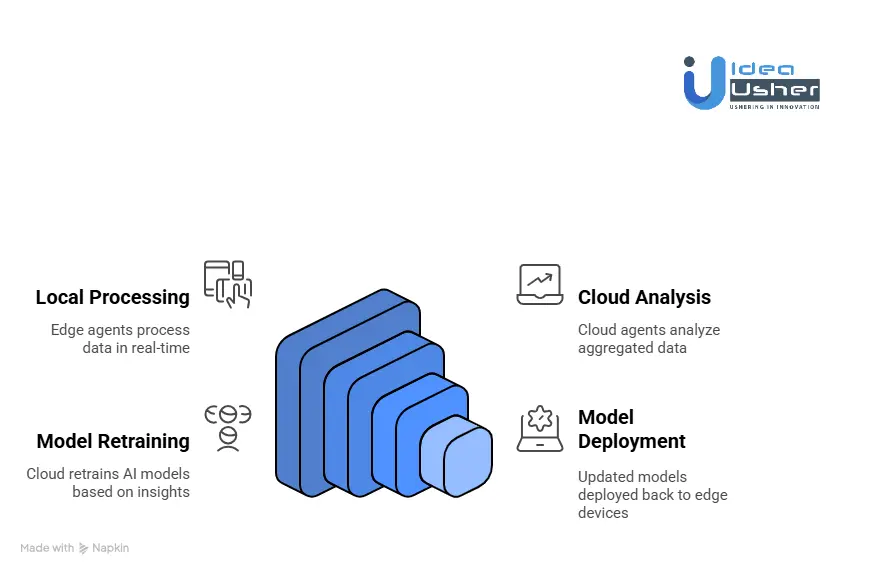
1. Giving “Perceive–Reason–Act” Loop a Home
At the heart of this architecture lies the Agentic Loop, which includes Perceive, Reason, and Act. It is now distributed across the Edge and Cloud to leverage their unique strengths.
Perceive & Act – The Edge’s Role
On the Edge, micro-agents embedded in sensors, cameras, and gateways constantly perceive their surroundings. They collect data such as video frames, temperature readings, and vibration signals, and act on it instantly using compact AI models.
Instead of streaming all raw data to the cloud, these agents make quick local decisions.
Reason & Learn – The Cloud’s Role
In the Cloud, the “Supervisor Agent” takes over the strategic thinking. It does not manage real-time reactions but focuses on broader reasoning, learning from aggregated Edge events.
Example: After analyzing data from hundreds of factory cameras, the Cloud Agent identifies that defects increase when a specific machine operates above a certain speed. It adjusts operational guidelines and pushes updated detection models to all Edge Agents.
2. Deciding What Happens Where
The system’s brilliance lies in how tasks are distributed between Edge and Cloud. The Cloud’s Supervisor Agent decomposes a complex objective such as “Optimize energy consumption this quarter” into smaller, actionable tasks.
Each task is assigned based on three simple rules:
- Latency Tolerance: Real-time tasks (<100ms) stay at the Edge.
- Data Scope: Single-device insights belong to the Edge, while cross-network insights go to the Cloud.
- Compute Complexity: Lightweight classifications run locally, while heavy simulations run centrally.
For instance, an Edge Agent maintains a room temperature at 21°C. But if it detects an unusual pattern suggesting a compressor issue, it escalates a structured event titled “Potential HVAC Failure – Code 74” to the Cloud for detailed analysis.
3. The Communication Fabric
The Edge and Cloud communicate through an asynchronous event mesh built on resilient technologies like MQTT or Kafka. This is not a constant dialogue but a message-driven flow.
- Edge Agents publish concise events such as “Anomaly Detected” or “Task Completed.”
- Cloud Agents subscribe to events relevant to their function.
If connectivity drops, Edge Agents continue working independently. Events queue automatically and sync once the link is restored, ensuring no data loss and uninterrupted intelligence flow.
4. The Continuous Learning Loop
This system learns continuously, much like a musician perfecting their craft through repetition and reflection.
- Edge Agents act and record outcomes.
- Results flow back to the Cloud as learning events.
- The Cloud reflects, identifying collective patterns and retraining the global AI model.
- Smarter models deploy back to all Edge devices seamlessly.
This creates a living, evolving ecosystem where every edge decision contributes to global intelligence, and every global improvement refines local performance.
How to Build Hybrid Edge-Cloud Agentic AI Architectures?
To build hybrid edge-cloud agentic AI architectures, you first decide which tasks stay on the Edge and which go to the Cloud. The Edge handles real-time operations, while the Cloud manages data processing and updates. We focus on secure communication and continuous learning to ensure everything works seamlessly.
Our team has designed and deployed numerous edge-cloud agentic AI architectures for clients worldwide, and this is how we approach it.
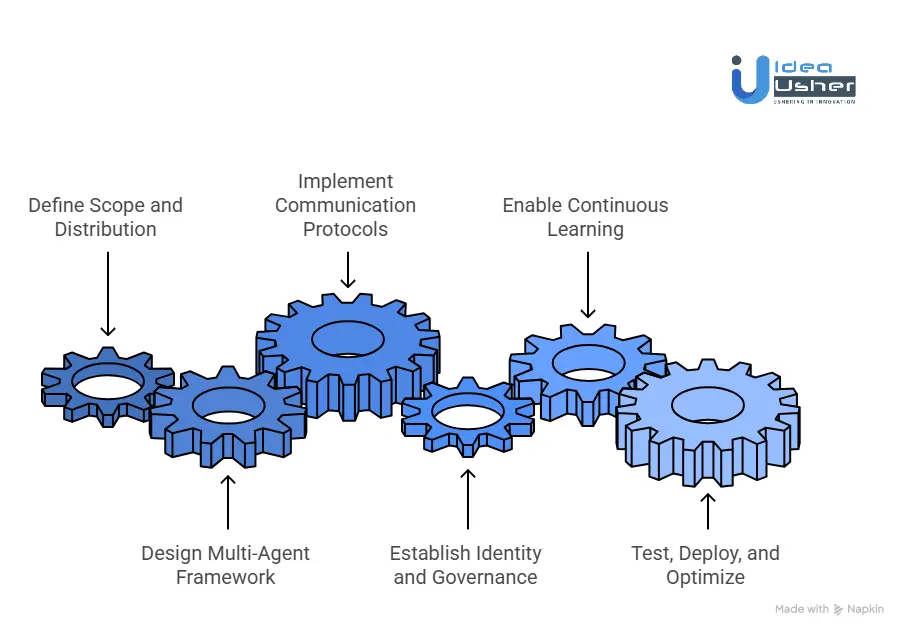
1. Define the Scope and Distribution
We define which functions will be handled locally at the Edge and which will be managed by the Cloud. Edge devices focus on real-time tasks like perception and actuation, while the Cloud takes care of reasoning and model retraining, optimizing the system’s performance.
2. Design the Multi-Agent Framework
We create a hierarchical agent framework with micro-agents at the Edge for real-time operations, and supervisor agents in the Cloud for high-level decision-making. Reflection agents help with continuous learning, improving system performance over time by feeding insights back into the system.
3. Implement Communication Protocols
We integrate messaging frameworks like Kafka, NATS, or MQTT for seamless, low-latency communication between Edge and Cloud. This ensures smooth data flow and real-time updates, even under fluctuating network conditions, allowing efficient interactions between Edge devices and Cloud-based agents.
4. Establish Identity and Governance
Security is key. We implement Zero-Trust frameworks and clear access policies to ensure secure authentication and authorization for every agent. Verifiable credentials are used to maintain governance and compliance, ensuring only trusted agents perform critical tasks.
5. Enable Continuous Learning
Our systems include a closed-loop learning process, where data from the Edge is sent to the Cloud for model retraining. Updated models are pushed back to the Edge, ensuring the system adapts and improves based on real-world data and outcomes.
6. Test, Deploy, and Optimize
We rigorously test the system under various conditions to ensure resilience, such as edge disconnections and workload fluctuations. Once deployed, we continuously optimize the smart hand-off between Edge and Cloud, ensuring the system performs at its best and remains adaptable to changing needs.
How Hybrid Edge-Cloud Agentic Architectures Boost Cost Savings?
Businesses can significantly reduce their operational costs by adopting hybrid edge-cloud agentic AI architectures. This approach merges the benefits of both edge computing (speed) and cloud computing (intelligence), creating a system that is not only faster and smarter but more efficient.
By implementing such a system, companies can expect a 20-35% reduction in core operational costs. The cost savings stem from three main financial benefits: reduced cloud data fees, avoiding costly downtime, and automating critical decision-making processes.
1. Reduction in Cloud Egress & Processing Costs
Legacy cloud AI architectures often require sending large volumes of raw data to the cloud for processing, resulting in high costs for both data transfer (egress fees) and computational resources.
The Agentic Edge Solution
By processing data locally at the edge through micro-agents, businesses can reduce the amount of raw data that needs to be sent to the cloud. Instead of streaming video, for example, only small, structured messages (e.g., “AnomalyDetected: Part_XYZ, Timestamp, Confidence_94%”) are transmitted when an event occurs. This minimizes both data volume and the associated costs.
Financial Calculation – A Smart Factory Example
Cloud-Centric Cost:
- Data per Camera: 500 GB/month (continuous video stream)
- Total Data: 100 cameras * 500 GB = 50,000 GB (50 TB) per month
- Cost: $5,000 – $8,000 per month for egress and processing
Hybrid Agentic Architecture Cost:
- Data per Camera: 5 GB/month (event metadata and compressed snapshots)
- Total Data: 100 cameras * 5 GB = 500 GB/month
- Cost: $50 – $80 per month for cloud services
- Edge Hardware/Software Cost: $2,000/month (amortized)
Monthly Savings: $5,000 – $8,000 (cloud costs) – $2,050 (hybrid architecture) = $3,000 – $6,000 savings (a 60-75% reduction).
This cost saving grows exponentially as businesses scale their operations, making the hybrid edge-cloud model particularly impactful.
2. Eliminating the Cost of Downtime
Unplanned downtime can have a devastating financial impact, especially in industries like manufacturing. For example, network outages that disrupt cloud-dependent AI systems can stop entire production lines, resulting in significant revenue loss.
The Agentic Edge Solution
With an agentic edge architecture, critical operational intelligence runs locally. This means that if the cloud connection is lost, the system can continue to perform its essential functions (e.g., quality control, robotic coordination, etc.) without interruption, minimizing downtime and associated costs.
Financial Calculation – An Automotive Assembly Line
Scenario: An automotive plant experiences an average of 3 hours of downtime per year, halting a line that costs $150,000 per hour in lost productivity.
Cloud-Centric Cost:
- Annual Downtime Cost: 3 hours * $150,000/hour = $450,000
Hybrid Agentic Architecture Impact:
- The system operates through network outages, reducing downtime to nearly zero.
- Savings: The entire $450,000 is preserved, protecting top-line revenue and reducing operational risk.
This savings is a direct protection against lost revenue, providing businesses with a significant financial buffer.
3. Labor Optimization & Process Efficiency
Many business operations still rely on human oversight for tasks like data analysis and decision-making, which can be slow, inconsistent, and costly. This human-in-the-loop model often results in inefficiencies and higher labor costs.
The Agentic Solution
Hybrid edge-cloud AI architectures enable AI agents to take over repetitive and time-consuming tasks autonomously. For example, an agent can monitor inventory levels, assess potential shortages, and automatically place orders with suppliers, all without human intervention. This leads to more efficient processes and reduces the need for manual labor.
Financial Calculation – A Logistics & Warehouse Example
Scenario: A warehouse employs 5 logistics coordinators at an average fully-loaded cost of $80,000 per year. These coordinators are responsible for inventory management, reordering, and exception handling.
Traditional Labor Cost:
- Annual Labor Cost: 5 coordinators * $80,000 = $400,000
Hybrid Agentic Architecture Impact:
- The AI system automates ~70% of the coordinators’ tasks, such as data analysis and purchase order generation, freeing up staff for more complex issues or allowing for staff reductions.
- The company can reduce its headcount by 3.5 FTEs (Full-Time Equivalents), resulting in labor savings.
Estimated Annual Labor Savings: 3.5 FTEs * $80,000 = $280,000
This estimate doesn’t include additional savings from fewer errors, faster response times, and optimized inventory management.

Businesses Save Up to 75% Energy with Edge-Cloud Agentic AI
Businesses can save up to 75% energy by using a hybrid edge-cloud agentic AI architecture for modern workloads. With this setup, AI processes are efficiently distributed between low-power edge devices and the cloud, reducing unnecessary data transmission and compute power.
This approach significantly lowers energy consumption and can help companies meet sustainability goals while boosting efficiency.
The Core Problem
Currently, many AI systems rely heavily on cloud infrastructure. Imagine a smart factory with 100 high-resolution cameras monitoring a production line for quality control. In a traditional setup:
- Continuous Video Streaming: Each camera streams raw, high-volume video footage to the cloud.
- Energy-Hungry Cloud Processing: Cloud servers use powerful, energy-intensive GPUs to analyze every frame of video around the clock.
This model results in massive energy consumption across three key areas:
- Powering the Cameras & Local Network: Keeping the system running 24/7.
- Data Transmission: Transmitting terabytes of data across the internet requires significant network energy.
- Cloud Compute: Running constant, high-energy AI processing on cloud servers.
The problem with this setup is simple: 99% of the data sent to the cloud is irrelevant; it’s just normal footage of a working production line, consuming massive amounts of energy.
The Solution
Hybrid Edge-Cloud Agentic AI changes the game by introducing intelligence at every level of the system to eliminate waste and optimize energy use. Here’s how it works:
1. The “Smart Filter” at the Edge
This is where businesses can see the largest energy savings. Instead of sending raw data to the cloud, Micro-Agents on edge devices process data locally.
How It Works
These agents run lightweight AI models on specialized, low-power chips, such as ARM CPUs or NVIDIA Jetson modules. Instead of streaming raw video, the edge device analyzes the footage in real-time and only sends a brief message to the cloud when it detects something significant. For example, “Anomaly Detected: Unit #8472, 14:32:01, Defect Type B.”
The Energy Impact:
This eliminates the need to send vast amounts of unnecessary data, which is one of the largest contributors to energy consumption in traditional cloud setups. Instead of sending a 500 GB video stream, only a 1 KB message is transmitted. This reduces the energy required for data transport, which is often a significant, yet overlooked, component of a business’s cloud energy bill.
2. “Right-Sizing” Compute Power
Using powerful cloud computing resources for simple tasks is inefficient, like trying to bake a loaf of bread in an industrial oven when a toaster would do just fine.
How It Works:
- Edge Compute: Edge devices, equipped with specialized processors, handle the simpler, repetitive tasks, such as running basic AI inferences. These processors are energy-efficient, designed for low-power operation.
- Cloud Compute: The cloud now takes on only the more complex tasks, such as heavy-duty processing, model retraining, or coordinating activities across devices, executed in batches rather than in a continuous stream.
The Energy Impact:
By shifting the workload to more efficient edge devices, businesses can significantly cut down on the energy consumption of cloud compute resources. The Cambridge study directly attributed much of the 75% energy savings to this optimal workload distribution; using the right tool for the right job.
3. Agentic Orchestration
The third layer of efficiency comes from intelligent orchestration. The cloud-based “Supervisor Agent” ensures all systems operate in sync while optimizing energy usage.
- How It Works: The Supervisor Agent makes dynamic, energy-conscious decisions. For instance, it may adjust the edge devices’ processing frequency during off-peak times or when anomalies are less likely. It might even put the devices in a low-power sleep mode during production downtime.
- The Energy Impact: This intelligent energy management layer ensures that every component of the system operates in the most energy-efficient manner possible. It continuously monitors and adapts, ensuring that no energy is wasted.
Common Challenges of Hybrid Edge-Cloud Agentic AI Architectures
Creating effective hybrid edge-cloud agentic AI architectures presents several technical challenges. These architectures are essential for efficient AI operations at the edge, while leveraging cloud resources for scalability, training, and decision-making.
Through our extensive experience with clients, we’ve identified common challenges in building these systems and developed practical solutions.
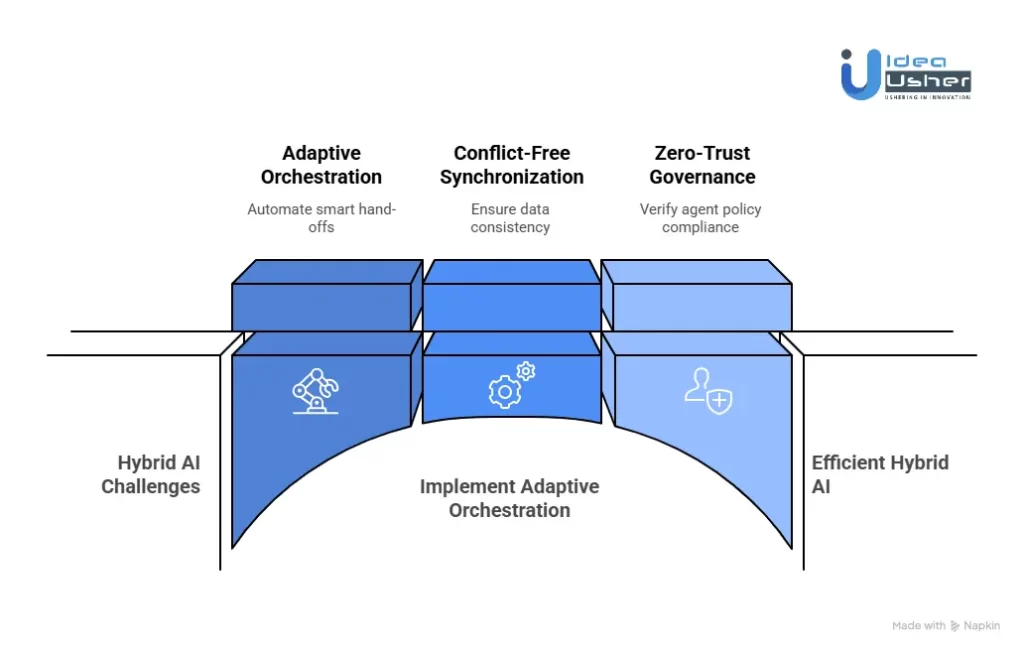
1. Cognitive Load Partitioning
In hybrid architectures, it can be difficult to effectively partition the cognitive load between edge devices and the cloud. Improper load distribution can lead to suboptimal performance, where either the edge devices are overwhelmed, or the cloud is underutilized.
Solution:
Implement adaptive orchestration to automate smart hand-offs between the edge and the cloud. This can dynamically adjust processing based on factors such as network conditions, resource availability, and task complexity.
By using machine learning models to predict the optimal distribution of tasks, you can ensure that each layer (edge or cloud) operates at peak efficiency. This helps to minimize latency and maximize throughput.
2. Data Synchronization
Ensuring data consistency between edge devices and cloud servers is one of the most common challenges in hybrid architectures. The edge may be operating in environments with intermittent connectivity, while the cloud often requires up-to-date data from the edge for accurate processing.
Solution:
Leverage Conflict-Free Replicated Data Types or vector clocks for conflict-free synchronization. These techniques ensure that data is synchronized in a manner that resolves conflicts automatically, even when devices are offline or disconnected.
CRDTs allow for concurrent changes at the edge, and vector clocks track causality, enabling seamless data reconciliation when devices reconnect to the cloud.
3. Agent Governance
Hybrid architectures often involve multiple AI agents that need to work in coordination across the edge and cloud. Over time, there is a risk of policy drift, where these agents may deviate from the defined governance policies due to changes in their environment, objectives, or training data.
Solution:
Apply Zero-Trust Agent Governance with runtime attestation to continuously verify that agents are following the correct policies. This involves authenticating and validating agents’ behavior and ensuring that they have not been tampered with.
Runtime attestation helps confirm that the agent is operating within its predefined boundaries, and Zero-Trust principles reduce the risk of unauthorized access or modification.

Tools & APIs for Hybrid Edge-Cloud Agentic AI Architectures
Building a hybrid architecture where autonomous AI agents operate seamlessly across both the edge and the cloud requires the right mix of technologies. This setup ensures efficient real-time processing at the edge while leveraging the cloud’s computational power for heavy tasks. Let’s explore the key components needed to bring your system to life.
1. Edge AI Tools
These frameworks allow AI models to run efficiently on edge devices, enabling real-time perception and decision-making without relying on constant cloud connectivity.
TensorFlow Lite / PyTorch Mobile
These frameworks are designed to optimize large, cloud-trained models for on-device inference. They transform models into lightweight versions that can run on resource-constrained edge hardware while maintaining performance.
NVIDIA Jetson SDK
For devices like the NVIDIA Jetson, the JetPack and TensorRT tools are critical. They optimize models to run efficiently on Jetson’s powerful GPU, making them perfect for high-throughput tasks like processing video streams and sensor data.
OpenVINO Toolkit
Intel’s OpenVINO toolkit helps optimize models for deployment across various Intel hardware, such as CPUs and VPUs. It is ideal for maximizing the performance of AI models on x86-based edge devices, enabling faster processing with lower power consumption.
2. Cloud AI Frameworks
While edge devices handle immediate tasks, the cloud performs the heavy lifting, training, complex reasoning, and long-term model management.
AWS SageMaker / Google Vertex AI / Azure Machine Learning
These managed platforms provide tools to manage the entire machine learning lifecycle, from data collection and model training to deployment and monitoring. You’ll use them to build and continuously retrain your models with data sent from your edge agents.
3. Event Mesh & Communication
The communication layer between edge and cloud agents must be resilient and able to handle intermittent connections, ensuring reliable data exchange.
MQTT
MQTT is a lightweight protocol ideal for constrained edge environments. It follows a publish-subscribe model where edge devices publish sensor readings, and cloud orchestrators subscribe to control messages. Its small data footprint is perfect for intermittent connections.
Kafka / NATS.io
For high-throughput, reliable event streaming, Kafka is a go-to solution in the cloud, able to handle millions of events from the edge. NATS.io is a simpler, faster alternative, known for its lightweight nature and high-speed messaging between distributed systems.
4. Governance and Identity
In a distributed system of autonomous agents, security and governance are crucial to prevent chaos and ensure that decisions are made within established boundaries.
Open Policy Agent (OPA)
OPA is a policy engine that lets you codify rules governing your agents’ behavior (e.g., “Only shut down the machine if temperature exceeds a specific threshold”). It decouples policy from application code, ensuring consistent, auditable governance.
SPIFFE/SPIRE
This framework provides secure identities for workloads, including both edge devices and cloud services. By ensuring agents can securely authenticate themselves, SPIFFE/SPIRE enables a zero-trust architecture, where no entity is trusted by default.
HashiCorp Vault
For securing secrets like API keys, passwords, and certificates, HashiCorp Vault provides a central, encrypted repository. It ensures that edge devices receive short-lived credentials dynamically, reducing the risk of secret exposure and improving security across distributed systems.
5. Orchestration and Deployment
Orchestration tools ensure smooth management, scaling, and deployment of AI agents across cloud and edge environments.
Kubernetes (K8s)
Kubernetes is the leading platform for managing containerized applications in the cloud. It provides tools to scale, deploy, and manage your cloud-native services, including agent applications, ensuring smooth operations and automatic scaling as needed.
K3s (Lightweight K8s)
K3s is a lightweight version of Kubernetes optimized for edge environments. It enables the same orchestration and management benefits of Kubernetes but tailored for the resource limitations of edge devices, ensuring consistency across the entire hybrid architecture.
Docker
Docker containers package code, models, and dependencies into a single, portable unit. Docker allows you to create a unified deployment pipeline, ensuring your edge agent applications can be seamlessly moved from development to the edge environment, regardless of the underlying hardware.
Conclusion
Hybrid edge-cloud agentic AI architectures are changing the way businesses function in distributed environments. By blending autonomy with resilience and intelligence, they create scalable systems that are always on and capable of self-improvement. For companies looking to build AI platforms that can adapt to future needs and drive revenue, this hybrid approach isn’t just a choice; it is essential. This model offers the flexibility and power to stay competitive as technology evolves, making it a key strategy for any forward-thinking business.
Looking to Develop Hybrid Edge-Cloud Agentic AI Architectures?
With over 500,000 hours of coding experience, our team of ex-MAANG/FAANG developers can help you build powerful hybrid edge-cloud agentic AI architectures. We focus on turning your ideas into scalable, secure, and efficient solutions that can grow with your business. Let us guide you through every step of the process, ensuring your architecture is robust and future-ready.
- From Concept to Deployment: We handle the entire lifecycle.
- Real-World Proven: Check out our latest projects to see our expertise in action.
- Built for Scale & Security: Architectures designed to grow and protect your busin
Explore our projects to see how we can help you build the future, today.
Add a few small pointers in the pitch
Work with Ex-MAANG developers to build next-gen apps schedule your consultation now
FAQs
A1: Industries like manufacturing, logistics, healthcare, retail, and energy benefit the most from this architecture. These sectors require low-latency operations, high data security, and scalable solutions. The ability to process data locally at the edge while maintaining cloud-based intelligence helps these industries streamline operations and stay responsive.
A2: The key difference lies in how data is processed. Traditional cloud AI relies on centralized systems where all data is sent to the cloud for analysis. In contrast, hybrid agentic systems process some decisions locally at the Edge. This ensures continuous operation even when there are network disruptions, making it more resilient and adaptive to real-time needs.
A3: Yes, existing cloud environments such as AWS or Azure can be easily extended to support this hybrid model. By adding an Edge layer and incorporating agentic orchestration frameworks, businesses can seamlessly integrate their current cloud systems with edge computing. This allows them to leverage the benefits of both local and cloud-based processing.
A4: Businesses can see a strong return on investment within 12 to 18 months. The benefits include improved uptime, faster decision cycles, reduced data transfer costs, and long-term efficiency gains. These advantages collectively lead to cost savings and increased productivity, making the hybrid edge-cloud architecture a worthwhile investment.
